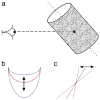Shape constancy and depth-order violations in structure from motion: a look at non-frontoparallel axes of rotation
- PMID: 17685799
- PMCID: PMC2246090
- DOI: 10.1167/7.7.3
Shape constancy and depth-order violations in structure from motion: a look at non-frontoparallel axes of rotation
Abstract
Humans can recover the structure of a 3D object from motion cues alone. Recovery of structure from motion (SFM) from the projected 2D motion field of a rotating object has been studied almost exclusively in one particular condition, that in which the axis of rotation lies in the frontoparallel plane. Here, we assess the ability of humans to recover SFM in the general case, where the axis of rotation may be slanted out of the frontoparallel plane. Using elliptical cylinders whose cross section was constant along the axis of rotation, we find that, across a range of parameters, subjects accurately matched the simulated shape of the cylinder regardless of how much the axis of rotation is inclined away from the frontoparallel plane. Yet, we also find that subjects do not perceive the inclination of the axis of rotation veridically. This combination of results violates a relationship between perceived angle of inclination and perceived shape that must hold if SFM is to be recovered from the instantaneous velocity field. The contradiction can be resolved if the angular speed of rotation is not consistently estimated from the instantaneous velocity field. This, in turn, predicts that variation in object size along the axis of rotation can cause depth-order violations along the line of sight. This prediction was verified using rotating circular cones as stimuli. Thus, as the axis of rotation changes its inclination, shape constancy is maintained through a trade-off. Humans perceive the structure of the object relative to a changing axis of rotation as unchanging by introducing an inconsistency between the perceived speed of rotation and the first-order optic flow. The observed depth-order violations are the cost of the trade-off.
Figures












Similar articles
-
A new theory of structure-from-motion perception.J Vis. 2009 Oct 26;9(11):23.1-20. doi: 10.1167/9.11.23. J Vis. 2009. PMID: 20053086 Free PMC article.
-
The influence of biological motion perception on structure-from-motion interpretations at different speeds.J Vis. 2006 Jun 22;6(7):712-26. doi: 10.1167/6.7.4. J Vis. 2006. PMID: 16895454
-
Integration of structure-from-motion and symmetry during surface perception.J Vis. 2010 Apr 14;10(4):5.1-17. doi: 10.1167/10.4.5. J Vis. 2010. PMID: 20465325
-
Perceiving shape from profiles.Percept Psychophys. 1994 Feb;55(2):152-61. doi: 10.3758/bf03211663. Percept Psychophys. 1994. PMID: 8036097
-
Isotropic integration of binocular disparity and relative motion in the perception of three-dimensional shape.Spat Vis. 2002;15(2):205-17. doi: 10.1163/15685680252875174. Spat Vis. 2002. PMID: 11991575
Cited by
-
A new theory of structure-from-motion perception.J Vis. 2009 Oct 26;9(11):23.1-20. doi: 10.1167/9.11.23. J Vis. 2009. PMID: 20053086 Free PMC article.
-
Form features provide a cue to the angular velocity of rotating objects.J Exp Psychol Hum Percept Perform. 2014 Feb;40(1):116-28. doi: 10.1037/a0033055. Epub 2013 Jun 10. J Exp Psychol Hum Percept Perform. 2014. PMID: 23750970 Free PMC article.
References
-
- Braunstein ML, Liter JC, Tittle JS. Recovering three-dimensional shape from perspective translations and orthographic rotations. Journal of Experimental Psychology: Human Perception and Performance. 1993;19:598–614. PubMed. - PubMed
-
- Caudek C, Domini F. Perceived orientation of axis of rotation in structure-from-motion. Journal of Experimental Psychology: Human Perception and Performance. 1998;24:609–621. PubMed. - PubMed
-
- Cornilleau-Peres V, Droulez J. Visual perception of surface curvature: Psychophysics of curvature detection induced by motion parallax. Perception & Psychophysics. 1989;46:351–364. PubMed. - PubMed
-
- Domini F, Braunstein ML. Recovery of 3-D structure from motion is neither Euclidean nor affine. Journal of Experimental Psychology: Human Perception and Performance. 1998;24:1273–1295. - PubMed
-
- Domini F, Caudek C, Proffitt DR. Misperceptions of angular velocities influence the perception of rigidity in the kinetic depth effect. Journal of Experimental Psychology: Human Perception and Performance. 1997;23:1111–1129. PubMed. - PubMed
Publication types
MeSH terms
Grants and funding
LinkOut - more resources
Full Text Sources

